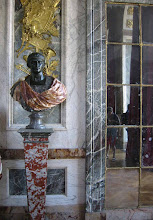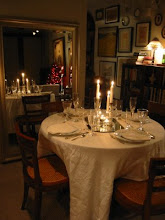
The evolution of a building is natural, much bemoaned by strict preservationist but it is the nature of time, particularly in cities; another topic for another day. A building which started out as the most luxurious apartment building here in Washington, DC now finds itself a distinguished office building holding none other than the
National Trust for Historic Preservation.

I was lucky enough to have a tour of the building a few months ago and while many changes have been made to the interiors to accomodate offices, it's extraordinary how many of the original details have been retained.

Construction began in late 1915 when a mansion previously occupying the site, the
Belden Noble residence, was torn down (seen below). The sturdy looking 3 story mansion was built in 1880, meaning it was only 36 years old when torn down. I was just talking to a friend just recently about how some things never change; so many of us still regard many buildings as temporary, even fine specimens such as this (yet again a subject for another post).

The neighborhood, Dupont Circle, was the heart of the cultural center of the city at the time (and some may argue still is) and the new building was designed to fit into this
city beautiful movement stretching across the country.

The owner of the property, Stanley McCormick, hired local architect
Jules Henri de Sibour (designer of many of the most beautiful mansions in the Dupont area now housing embassies) to design a large Beaux-Art Louis XVI styled building which would house 6 luxury apartments with servant quarters for up to 40 employees.

The apartments are palatial and were rented out at prices that seem high, even today. Because of this, the tenant list reads as a veritable 'Who's Who' of the DC social scene from the era. Most famously, Andrew Mellon lived in the penthouse apartment while Secretary of the Treasury and later while building his art collection which would eventually become the foundation of the
National Gallery of Art (an interesting story for my next post related to the building).

In 1941, the building was leant to the British Army for use during the war for purchasing and since has had many commercial tenants including NCARB (National Architectural Accrediting Board, Inc) , the national AIA, the American Council on Education and has been home for years now to the National Trust for historic preservation (who recently tried to unsuccessfully sell the building).

Despite having lived longer as an office building than as an apartment house, the building fortunately retains much of its early detail. One enters a rounded corner at the corner of Massachusetts Avenue and 18th Street NW into a small round lobby seen here.

Unlike luxury apartment buildings in the city today, there were no shared amenities per say. Rather, the public spaces, while beautiful, are small and efficient. No swimming pool , roof deck or gym were offered to the tenants!

From the entry lobby, one stepped up into a marble lined vestibule which contained doorways into two smaller apartments, 3 seperate elevators (one for service staff) and the main staircase (which wraps around the primary elevator).

The plaster work in the lobby is astounding and even more amazing is that it has survived intact for so many years.

The marble floors are an added bonus in Washington as it gets rather hot here in the summer and this was built pre-air conditioning. However, most of the tenants were here only during the winter 'season' and would not have had to worry about this inconvienence.

The marble main staircase, while wide and gracious, is rather utilitarian with simple moldings but originally had windows opening onto an air shaft for natural light and ventilation which has since been enclosed.

The landings outside of each apartment continue the simple moldings and 12" square black & white marble floors.

Join me next week as I show details from these original apartments, a typical floor plan is below to whet your appetite!

Color photographs are my own but the historical images come from the book "
Massachusetts Avenue Architecture, Volume 1" produced by the Commission of Fine Arts in 1973.
 The evolution of a building is natural, much bemoaned by strict preservationist but it is the nature of time, particularly in cities; another topic for another day. A building which started out as the most luxurious apartment building here in Washington, DC now finds itself a distinguished office building holding none other than the National Trust for Historic Preservation.
The evolution of a building is natural, much bemoaned by strict preservationist but it is the nature of time, particularly in cities; another topic for another day. A building which started out as the most luxurious apartment building here in Washington, DC now finds itself a distinguished office building holding none other than the National Trust for Historic Preservation. I was lucky enough to have a tour of the building a few months ago and while many changes have been made to the interiors to accomodate offices, it's extraordinary how many of the original details have been retained.
I was lucky enough to have a tour of the building a few months ago and while many changes have been made to the interiors to accomodate offices, it's extraordinary how many of the original details have been retained.  Construction began in late 1915 when a mansion previously occupying the site, the Belden Noble residence, was torn down (seen below). The sturdy looking 3 story mansion was built in 1880, meaning it was only 36 years old when torn down. I was just talking to a friend just recently about how some things never change; so many of us still regard many buildings as temporary, even fine specimens such as this (yet again a subject for another post).
Construction began in late 1915 when a mansion previously occupying the site, the Belden Noble residence, was torn down (seen below). The sturdy looking 3 story mansion was built in 1880, meaning it was only 36 years old when torn down. I was just talking to a friend just recently about how some things never change; so many of us still regard many buildings as temporary, even fine specimens such as this (yet again a subject for another post). The neighborhood, Dupont Circle, was the heart of the cultural center of the city at the time (and some may argue still is) and the new building was designed to fit into this city beautiful movement stretching across the country.
The neighborhood, Dupont Circle, was the heart of the cultural center of the city at the time (and some may argue still is) and the new building was designed to fit into this city beautiful movement stretching across the country. The owner of the property, Stanley McCormick, hired local architect Jules Henri de Sibour (designer of many of the most beautiful mansions in the Dupont area now housing embassies) to design a large Beaux-Art Louis XVI styled building which would house 6 luxury apartments with servant quarters for up to 40 employees.
The owner of the property, Stanley McCormick, hired local architect Jules Henri de Sibour (designer of many of the most beautiful mansions in the Dupont area now housing embassies) to design a large Beaux-Art Louis XVI styled building which would house 6 luxury apartments with servant quarters for up to 40 employees. The apartments are palatial and were rented out at prices that seem high, even today. Because of this, the tenant list reads as a veritable 'Who's Who' of the DC social scene from the era. Most famously, Andrew Mellon lived in the penthouse apartment while Secretary of the Treasury and later while building his art collection which would eventually become the foundation of the National Gallery of Art (an interesting story for my next post related to the building).
The apartments are palatial and were rented out at prices that seem high, even today. Because of this, the tenant list reads as a veritable 'Who's Who' of the DC social scene from the era. Most famously, Andrew Mellon lived in the penthouse apartment while Secretary of the Treasury and later while building his art collection which would eventually become the foundation of the National Gallery of Art (an interesting story for my next post related to the building). In 1941, the building was leant to the British Army for use during the war for purchasing and since has had many commercial tenants including NCARB (National Architectural Accrediting Board, Inc) , the national AIA, the American Council on Education and has been home for years now to the National Trust for historic preservation (who recently tried to unsuccessfully sell the building).
In 1941, the building was leant to the British Army for use during the war for purchasing and since has had many commercial tenants including NCARB (National Architectural Accrediting Board, Inc) , the national AIA, the American Council on Education and has been home for years now to the National Trust for historic preservation (who recently tried to unsuccessfully sell the building). Despite having lived longer as an office building than as an apartment house, the building fortunately retains much of its early detail. One enters a rounded corner at the corner of Massachusetts Avenue and 18th Street NW into a small round lobby seen here.
Despite having lived longer as an office building than as an apartment house, the building fortunately retains much of its early detail. One enters a rounded corner at the corner of Massachusetts Avenue and 18th Street NW into a small round lobby seen here. Unlike luxury apartment buildings in the city today, there were no shared amenities per say. Rather, the public spaces, while beautiful, are small and efficient. No swimming pool , roof deck or gym were offered to the tenants!
Unlike luxury apartment buildings in the city today, there were no shared amenities per say. Rather, the public spaces, while beautiful, are small and efficient. No swimming pool , roof deck or gym were offered to the tenants! From the entry lobby, one stepped up into a marble lined vestibule which contained doorways into two smaller apartments, 3 seperate elevators (one for service staff) and the main staircase (which wraps around the primary elevator).
From the entry lobby, one stepped up into a marble lined vestibule which contained doorways into two smaller apartments, 3 seperate elevators (one for service staff) and the main staircase (which wraps around the primary elevator). The plaster work in the lobby is astounding and even more amazing is that it has survived intact for so many years.
The plaster work in the lobby is astounding and even more amazing is that it has survived intact for so many years. The marble floors are an added bonus in Washington as it gets rather hot here in the summer and this was built pre-air conditioning. However, most of the tenants were here only during the winter 'season' and would not have had to worry about this inconvienence.
The marble floors are an added bonus in Washington as it gets rather hot here in the summer and this was built pre-air conditioning. However, most of the tenants were here only during the winter 'season' and would not have had to worry about this inconvienence. The marble main staircase, while wide and gracious, is rather utilitarian with simple moldings but originally had windows opening onto an air shaft for natural light and ventilation which has since been enclosed.
The marble main staircase, while wide and gracious, is rather utilitarian with simple moldings but originally had windows opening onto an air shaft for natural light and ventilation which has since been enclosed. The landings outside of each apartment continue the simple moldings and 12" square black & white marble floors.
The landings outside of each apartment continue the simple moldings and 12" square black & white marble floors. Join me next week as I show details from these original apartments, a typical floor plan is below to whet your appetite!
Join me next week as I show details from these original apartments, a typical floor plan is below to whet your appetite! Color photographs are my own but the historical images come from the book "Massachusetts Avenue Architecture, Volume 1" produced by the Commission of Fine Arts in 1973.
Color photographs are my own but the historical images come from the book "Massachusetts Avenue Architecture, Volume 1" produced by the Commission of Fine Arts in 1973.














































.JPG)







































































